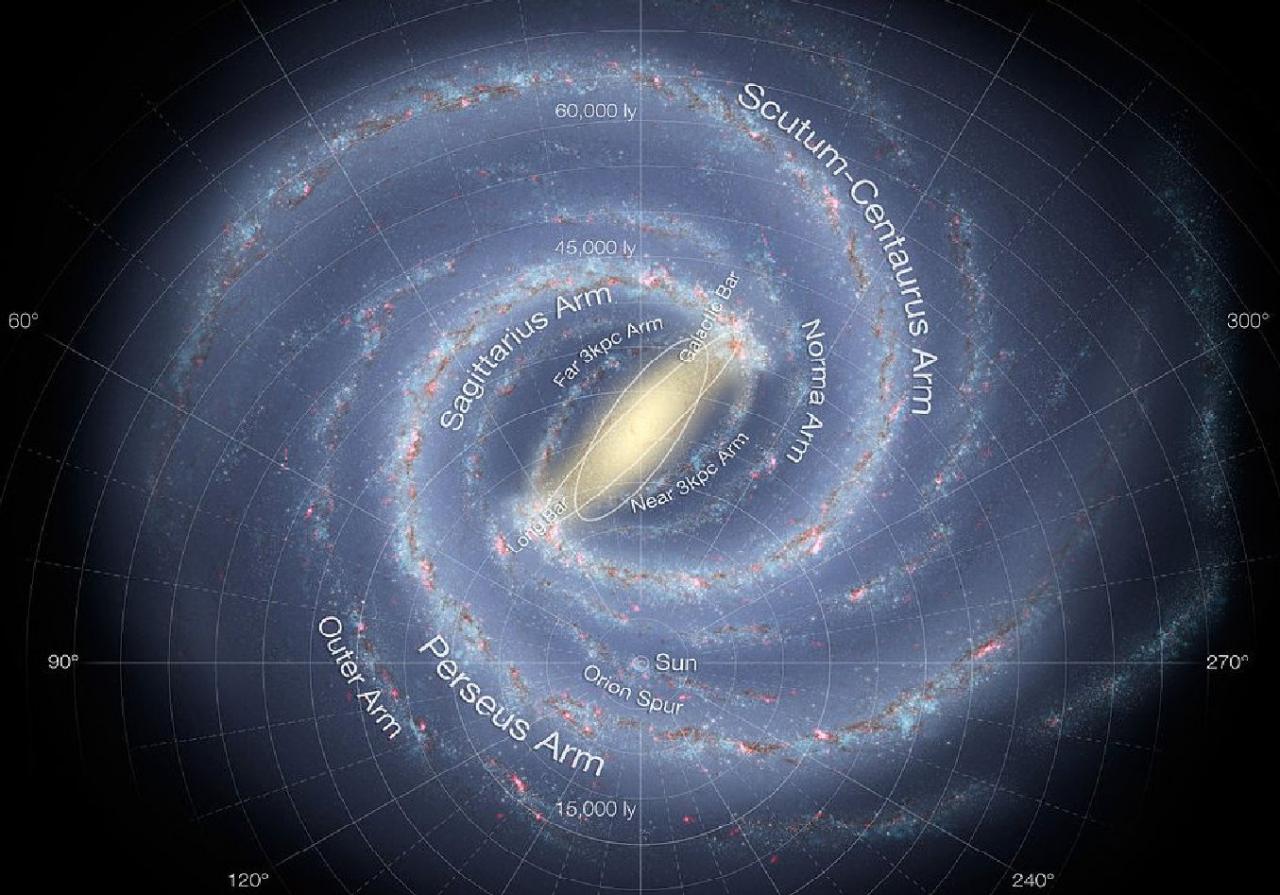Grants related:
General
This project consists of two parts, each differentiated but both complementary: morphology and dynamics. Detailed study of the morphology of the Milky Way pretends to provide a data base for the stellar distribution in the most remote and heavily obscured regions of our Galaxy, through the development of semiempirical models based on the information in these catalogues. Kinematic and dynamical analysis, on the other hand, aims to aid our understanding of the origin of these observed features.
Our group has used a combination of its own data (which will include in the future spectroscopical observations with GRANTECAN/EMIR) and public-domain catalogues either in photometry (DENIS, 2MASS, UKIDSS, VISTA, SDSS) or spectroscopy (SDSS-APOGEE in near infrared, LAMOST). We have gathered detailed information on the stellar distribution of the dominant populations over a wide area of sky containing different structural components: the triaxial bulge, the long bar, the disc, the spiral arms, etc. The components of gas and dust are also a matter of study in infrared, or in microwave (analyses of Galactic contamination over the cosmic microwave background radiation, for instance with WMAP or PLANCK). Our research team has also become part of the Spanish node of Gaia with the idea of orientating part of our work towards the scientific exploitation of this mission, particularly with regard to the identification and study of large scale stellar populations in the Galaxy.
Members
Results
- Milky Way's disk much larger than previously thought. See press release of IAC: http://www.iac.es/divulgacion.php?op1=16&id=1385&lang=en
Scientific activity
Related publications
-
Vertical velocities from proper motions of red clump giants
Aims: We derive the vertical velocities of disk stars in the range of Galactocentric radii of R = 5 - 16 kpc within 2 kpc in height from the Galactic plane. This kinematic information is connected to dynamical aspects in the formation and evolution of the Milky Way, such as the passage of satellites and vertical resonance and determines whether the
López-Corredoira, M. et al.Advertised on:
122014 -
Optical Study of the Hyper-luminous X-Ray Source 2XMM J011942.7+032421
We present the identification and characterization of the optical counterpart to 2XMM J011942.7+032421, one of the most luminous and distant ultra-luminous X-ray sources (ULXs). The counterpart is located near a star-forming region in a spiral arm of the galaxy NGC 470 with u, g, and r magnitudes of 21.53, 21.69, and 21.71 mag, respectively. The
Gutiérrez, C. M. et al.Advertised on:
122014 -
On the dust content of galaxy clusters
Context. Most of the contribution to dust emission in clusters of galaxies comes from late-type galaxies. However, several ejection processes of material from these galaxies could introduce dust in the intracluster media. Even a relatively low abundance of this dust could act as an efficient cooling agent and have a relevant role in the evolution
Gutiérrez, C. M. et al.Advertised on:
112014 -
Three-dimensional decomposition of galaxies with bulge and long bar
Context. Some observations indicate that the Milky Way has two inner components, a bulge and a long bar, which present a misalignment of Δα ≃ 20° that is against the predictions of some theoretical models that are based on numerical simulations. Aims: We wish to determine whether this misalignment between the bar and the bulge can be observed in
Compère, P. et al.Advertised on:
112014 -
Dynamical evolution of two associated galactic bars
We study the dynamical interactions of mass systems in equilibrium under their own gravity that mutually exert and experience gravitational forces. The method we employ is to model the dynamical evolution of two isolated bars, hosted within the same galactic system, under their mutual gravitational interaction. In this study, we present an
Garzón, F. et al.Advertised on:
102014 -
Flare in the Galactic stellar outer disc detected in SDSS-SEGUE data
Aims: We explore the outer Galactic disc up to a Galactocentric distance of ≈30 kpc to derive its parameters and measure the magnitude of its flare. Methods: We obtained the 3D density of stars of type F8V-G5V with a colour selection from extinction-corrected photometric data of the Sloan Digital Sky Survey - Sloan Extension for Galactic
López-Corredoira, M. et al.Advertised on:
72014 -
The triggering mechanism and properties of ionized outflows in the nearest obscured quasars
We have identified ionized outflows in the narrow-line region of all but one Sloan Digital Sky Survey type 2 quasars (QSO2) at z≲0.1 (20/21, detection rate 95 per cent), implying that this is a ubiquitous phenomenon in this object class also at the lowest z. The outflowing gas has high densities (ne≳1000 cm-3) and covers a region the size of a few
Villar Martín, M. et al.Advertised on:
42014 -
Milky Way rotation curve from proper motions of red clump giants
Aims: We derive the stellar rotation curve of the Galaxy in the range of Galactocentric radii of R = 4-16 kpc at different vertical heights from the Galactic plane of z between -2 and +2 kpc. With this we reach high Galactocentric distances in which the kinematics is poorly known due mainly to uncertainties in the distances to the sources. Methods
López-Corredoira, M.Advertised on:
32014 -
Infrared Extinction in the Inner Milky Way through Red Clump Giants
While the shape of the extinction curve in the infrared is considered to be set and the extinction ratios between infrared bands are usually taken to be approximately constant, a number of recent studies point to either a spatially variable behavior of the exponent of the power law or a different extinction law altogether. In this paper, we propose
Hammersley, P. L. et al.Advertised on:
22014 -
The long bar as seen by the VVV Survey. II. Star counts
Context. There is still some debate about the presence and the morphological properties of the long bar in the inner Galaxy. Aims: We investigate the morphological properties of the long Galactic bar using the VVV survey extending star counts at least 3 mag deeper than 2MASS. Our study covers the relatively unexplored negative longitudes of the
Amôres, E. B. et al.Advertised on:
112013 -
Discovery of the Broad-lined Type Ic SN 2013cq Associated with the Very Energetic GRB 130427A
Long-duration gamma-ray bursts (GRBs) at z < 1 are found in most cases to be accompanied by bright, broad-lined Type Ic supernovae (SNe Ic-BL). The highest-energy GRBs are mostly located at higher redshifts, where the associated SNe are hard to detect observationally. Here, we present early and late observations of the optical counterpart of the
de Ugarte Postigo, A. et al.Advertised on:
102013 -
Multiwavelength Observations of the Black Hole Transient XTE J1752–223 during Its 2010 Outburst Decay
Galactic black hole transients show many interesting phenomena during outburst decays. We present simultaneous X-ray (RXTE, Swift, and INTEGRAL), and optical/near-infrared (O/NIR) observations (SMARTS) of the X-ray transient XTE J1752–223 during its outburst decay in 2010. The multiwavelength observations over 150 days in 2010 cover the transition
Chun, Y. Y. et al.Advertised on:
62013 -
Luminosity-colour relations for red clump stars
We calibrated the absolute magnitudes M V , M J , M_{Ks} and M g of red clump stars in terms of colours. M V and M g are strongly dependent on colour, while the dependence of M J and M_{Ks} on colour is rather weak. The calibration of the absolute magnitudes M V and M_{Ks} is tested on 101 RC stars in the field SA 141. The Galactic model parameters
Çakmak, H. et al.Advertised on:
42013 -
Five fake ultra-luminous X-ray sources
Context. The nature of ultra-luminous X-ray (ULX) sources is still a matter of debate. Studies of their counterparts in other spectral ranges will help to clarify the nature of those sources. Aims: Our goal was to identify and characterize the optical counterparts of five sources catalogued as ULXs. Methods: We obtained optical imaging and
Gutiérrez, C. M.Advertised on:
12013 -
Stars and brown dwarfs in the σ Orionis cluster. III. OSIRIS/GTC low-resolution spectroscopy of variable sources
Context. Although many studies have been performed so far, there are still dozens of low-mass stars and brown dwarfs in the young σ Orionis open cluster without detailed spectroscopic characterisation. Aims: We look for unknown strong accretors and disc hosts that were undetected in previous surveys. Methods: We collected low-resolution
Caballero, J. A. et al.Advertised on:
102012 -
The long bar as seen by the VVV survey. I. Colour-magnitude diagrams
Context. The VISTA Variable Survey (VVV) is able to map the Galaxy at l ≤ 0° with an unpaired depth (at least 3 mag deeper than 2MASS), opening new possibilities for studying the inner structure of the Milky Way. Aims: In this paper we concentrate on the exploitation of these data to better understand the spatial disposition and distribution of the
González-Fernández, C. et al.Advertised on:
102012 -
Deep blank-field catalogue for medium- and large-sized telescopes
The observation of blank fields, defined as regions of the sky that are devoid of stars down to a given threshold magnitude, constitutes one of the most relevant calibration procedures required for the proper reduction of astronomical data obtained following typical observing strategies. In this work, we have used Delaunay triangulation to search
Jiménez Esteban, F. M. et al.Advertised on:
112012 -
Spectroscopy and multiband photometry of the afterglow of intermediate duration γ-ray burst GRB 040924 and its host galaxy
Aims: We present optical photometry and spectroscopy of the afterglow and host galaxy of gamma-ray burst GRB 040924. This GRB had a rather short duration of T90 ~2.4 s, and a well sampled optical afterglow light curve. We aim to use this dataset to find further evidence that this burst is consistent with a massive star core-collapse progenitor
Wiersema, K. et al.Advertised on:
42008 -
Near-IR spectra of inner red giants (Gonzalez-Fernandez+, 2008)
From the equivalent widths of the main features of the K band spectra (the NaI, CaI and CO bandheads) we have derived the metallicities of the sources by means of the empirical scale obtained by Ramirez et al. (2000AJ....120..833R) and Frogel et al. (2001AJ....122.1896F) for luminous red giants. (2 data files).
Gonzalez-Fernandez, C. et al.Advertised on:
22008 -
2MASS, SDSS and BVRI photometry for 825 stars (Bilir+, 2008)
We present colour transformations for the conversion of the 2MASS photometric system to the Johnson-Cousins UBVRI system and further into the SDSS ugriz system. We have taken SDSS gri magnitudes of stars measured with the 2.5-m telescope from SDSS Data Release 5 (DR5), and BVRI and JHKs magnitudes from Stetson's catalogue (available at http://www2
Bilir, S. et al.Advertised on:
72008



